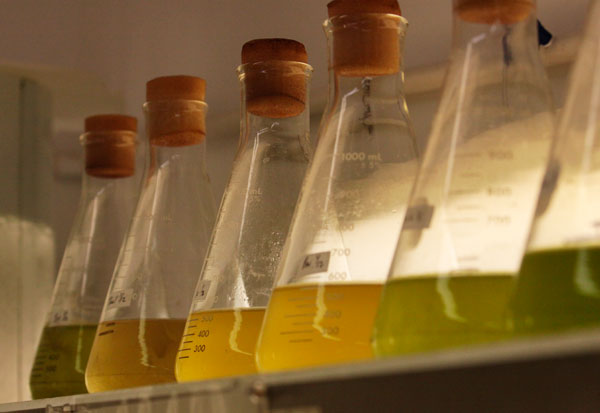
Grow room by the Sea -- Algae stock grows in Erlenmeyer flasks at the East Hampton Town Shellfish Hatchery in Mondauk, NY. The algae provides microscopic food for infant oysters, clams and scallops (while they're in the larval stage). In the next stage, the algae cultures are moved to much larger vats where the algae blooms under natural light. Photo by Eric Francis.
When I was studying marine biology at John Dewey High School, I heard of this place called the New York Ocean Science Laboratory (NYOSL), out in Montauk — at the far end of Long Island’s south fork. That always seemed perfect — to have an ocean science lab out here on the far-flung edge of the North American continent, more than 100 miles out into the Atlantic Ocean. All kinds of complex aquatic systems exist around here — besides the ocean itself, there are inland lakes and ponds, streams, bays, harbors, wetlands and islands.
I’ve looked for the lab many times on the ‘Net and I’ve never been able to find it — and I learned why today. The New York State Legislature cut its funding in 1979, before the Internet existed. So, it never had a website or a web presence of any kind, and there are few references to its existence. Even asking the locals, most only seemed to have heard of it.
The land was almost all sold to build condos, and most of the place (originally a former WW II torpedo testing facility) was torn down. The one remaining building fell into ruins. Then in 1986, someone thought to open a shellfish hatchery. NYOSL’s remaining structure was renovated and revived, and the Town of East Hampton (which includes the hamlet of Montauk) created a place to breed clams, scallops and oysters. So many of these critters are harvested from the water that the stocks were nearly depleted before World War II. So it makes sense to reinvest in the ecosystem.
With some help from the local newspaper, I tracked down the lab’s manager and visited there today. It’s a gritty little operation, with a small staff. The facility is designed to get mollusks to mate, which they do by spewing their sex cells into the water — and then collect the larvae. These are fed algae, which is bred first in beakers like the ones you see above, then in larger vats. Only the smallest fish eat algae stock; once they’re big enough, they are put out into a nursery or live on racks, in both of which cases they consume the naturally occurring algae in bay water.
Both Chiron and Neptune in Pisces are going to call attention to the oceans. The oceans are the immune system of the planet, and the wetlands are the spawning grounds where nearly all marine life has its roots. Chiron in Pisces is the essence of marine science — the spirit of inquiry, documentation and acknowledgement of the issues we face and the healing that’s necessary.
We’re going to need both scientists and facilities to understand and help us deal with the changes the world is going through. This has been true for as long as there’s been industrialization, though I can tell you from much experience covering polluters that they don’t like scientists. They don’t like research. The less that’s known about the effects of all this industrial activity and pollution, the better. Not everyone agrees with that.
The East Hampton hatchery is not a research lab; it provides a practical function, which is restocking the waters from which so many people eat and make a living. That’s a good start. I’ll post another photo to Planet Waves tomorrow.

